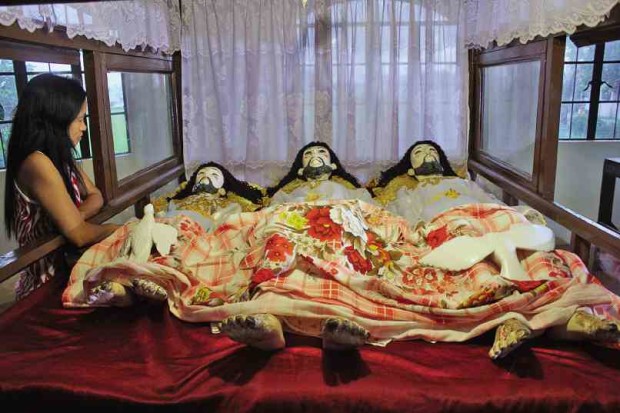Trio of Dead Christ venerated in village

A DEVOTEE offers prayers at the shrine of Tolong Hinulid in Gainza, Camarines Sur province. JUAN ESCANDOR JR.
WITH ONLY eight villages, Gainza is the smallest among the 35 towns and two cities of Camarines Sur province, but it is expected to draw a large number of pilgrims who will venerate its three statues of the dead Jesus Christ.
These statues, reverently called Tolong Hinulid (“tolong” means three while “hinulid” refers to someone laid to rest), were discovered in the same spot along a river in different periods of flooding in Gainza, according to accounts of residents of Cagbunga. The village is 5 kilometers northwest of Naga City and is accessible from the national highway through a concrete road crossing ricefields.
Nobody could say when the images comprising the trio of Hinulid were completed.
Salvacion San Juan, 64, recalled that when she was young, she used to sneak into a bed in a room in their house where the Tolong Hinulid are kept. She giggled, remembering her father picking her up every time she would fall asleep beside the Tolong Hinulid.
San Juan believed the devotion to the Tolong Hinulid might have started 100 years ago because her grandfather had told her about his devotion since childhood.
Article continues after this advertisementWhen her father died several years ago at age 84, San Juan said the Tolong Hinulid was entrusted to the community. From then on, the Parish Pastoral Council (PPC) took care of the statues in a chapel built to house these.
Article continues after this advertisementPlaced inside a glass-encased platform at the backroom of the chapel, the wooden statues have different tortured expression, with bloody cuts in the faces.
Their lengths or heights vary. The tallest, at 1.52 meters (5 feet), lies in the middle and is flanked on the right by a 1.25-meter (4 feet, 11 inches) Hinulid and on the left, the shortest image at 1.21 meters (4 feet).
They have identical garb of white satin embroidered with gold stitches along the neckline and knotted belt of gold-colored rope and are accompanied by replicas of two white doves placed on their legs, which devotees say help bring their messages to God.
A devotee has to touch and kiss the bare feet of the statues while praying, and hold the dove replica as they say their prayers and deliver other wishes to God.
The ritual of bathing the Tolong Hinulid every Maundy Thursday has become a tradition that has drawn devotees from neighboring towns. It begins at 2 p.m. after the members of the PPC had prayed around the Tolong Hinulid. They dab the statues’ bodies with cotton dipped from several pails of water that would, in turn, be used to treat ailments.
Water used during the bathing is apportioned to devotees who wait until the ritual is completed.
Jose Teodoro Jr., 52, PPC chair, does not have enough information as to how and when the three statues ended up in their village, which is crisscrossed by meandering tributaries of the Bicol River.
Neither could he not find a rational explanation how these remained together, even though they were swept away by floodwater from the chapel when Typhoon “Sening” battered Bicol when he was 6 years old.
From a chapel made of nipa shingles and bamboo years ago, the Tolong Hinulid is now housed in a concrete chapel with the elevated backroom of the altar constructed to protect the statues from floods.
The Tolong Hinulid are sustained by donations from devotees that reach an average of P3,000 a month and thousands of pesos during the Lenten season, he said.
Teodoro said the number of devotees was increasing by the year. During the observance of the Holy Week last year, more than 1,000 came until Good Friday, with people standing shoulder to shoulder as they crowded the streets going to the chapel.